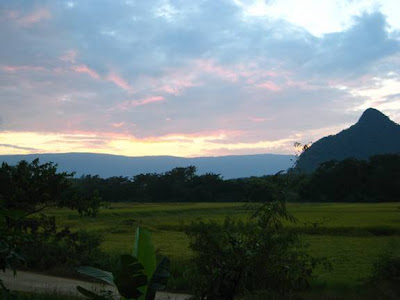
Our CIEE group most recently finished our Unit 4 which focused on mining issues in Northeastern Thailand. The Phu Thap Pha gold mine is located in the Loei Province of the Isaan region. After being introduced to the issue with a series of pertinent lectures and readings, we departed to the village of Na Nong Bong to exchange and engage with the parties involved. The village of Na Nong Bong is located approximately 1 km away from the gold mine operated by Tongkah Harbor Plc (THL)., and swirls directly in the center of the gold mine controversy.
A brief summary of the controversy that exists deals with the fact that villagers from the surrounding areas are experiencing adverse health and environmental effects since the Phu Thap Pha gold mine opened in 2006. Water tests have been conducted from 2004 up until 2009 and have found chemical substances including cyanide, manganese, cadmium, lead and arsenic have contaminated the surface and groundwater in the areas surrounding the mine. While these tests have been conducted there is no evidence that can directly link the gold mine to these results since no prior baseline tests had been conducted before the mine was built and operating. Negative health effects experienced by some villagers in these surrounding areas include rashes, headaches, eye pain, nausea and more severe side effects include vomiting, nausea and blackouts. One villager, Ms. Leng Wongkemsom, 54 years old, has been diagnosed with cyanide poison and experiences the severe side effects of her illness daily.
The government has advised the villagers not to drink or cook with the water. While this notice has been given, the Provincial Health Office and the other agencies involved have not come up with any solutions to alleviate the problem of this contaminated water. Villagers now are forced to spend the little money they have on bottled water, but often still bathe, do laundry and dishes with the contaminated water. Our group of CIEE international students visited the village firsthand during our seven day stay at Na Nong Bong. While some of us took showers, and some of us did not, I think I can say that we were more than a bit nervous taking showers even though the most recent 2009 groundwater tests showed that there was 0.03 and 0.1 milligrams per liter of arsenic at 2 of the 9 test sites in the area, respectively. There was also 0.11 milligrams per liter of lead found at one site, and 0.01 mg/l of cadmium at another. No cyanide was found in the ground or surface water in two separate 2009 tests. However for these substances, the World Health Organization has not set any minimum standards for bathing. As for manganese, cadmium, lead and arsenic, health can be affected through long term exposure.
One thing that really shocked me during this unit was how solutions for this problem seem to be nonexistent or at a standstill. People have been diagnosed with cyanide poisoning. Water results have confirmed that dangerous, harmful containments are present and while there is debate on where this problem originates from, gold mine bi-products or not, there should be no debate or lack of urgency in finding ways to protect these villagers from an all too real and current problem. In the past water trucks started to deliver fresh water for a short time until it became too expensive and a hassle for the government. No other solutions have been discussed with the villagers. Data, water tests, villager petitions, and community demands for solutions regarding the problem seem to be diverted from one department of government unto the next, like a horrible game of hot potato, no one wanting to take responsibility for the pressing issue at hand. While this happens, the children, parents and elders of these affected Thai communities shower in contaminated water and spend their savings on water to drink.
This takes place in Thailand, but health issues of a similar sort can still be found back home in the United States. A mining issue all too familiar to the plight of Na Nong Bong village can be found in Floyd County, Kentucky. Here we have a coal mine which also negatively effects the environment and the health of the individuals that live there. With this in mind, I think of the global implications and effects of our industrialized society and wonder if we can change so we don’t hurt people, families, and communities near these areas. I hope that when we do adversely affect these places we can recognize and help fix these problems as quickly as possible. No dilly dallying is needed. I know personally that villages affected in Loei province are open to solutions and that they are open to solutions now. With strong collective movements in both of the examples shown in this blog, specifically Na Nong Bong and Floyd County, Kentucky, I hope that solutions, health-wise and environmentally, can be found. I hope that that these voices will eventually be heard and their rights to a healthy life restored.
Scott Pulido
University of Michigan


No comments:
Post a Comment